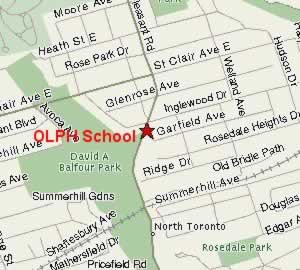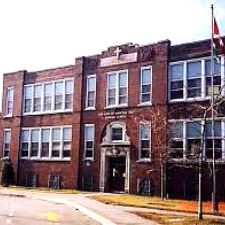
Our Lady of Perpetual Help Catholic School (Elementary)
Address: 1½ Garfield Avenue
(near St. Clair Ave. East and Mt. Pleasant Blvd)
Toronto, ON M4T 1E6

Tel (416) 393-5239
Fax (416) 393-5818
OLPH School Web site: https://www.olphcs.com/
Principal: Ms. Rania Zaccak-Di Felice
School board website: www.tcdsb.org/schools/ourladyofperpetualhelp/Pages/default.aspx
Relationship between OLPH Church and OLPH School

The relationship between the parish church and the local Catholic school is a very important one. It is a relationship that demands the interest and goodwill of the pastor, school staff and the parents.
It likewise needs to be noted that in order to be really effective, the relationship between the church and the school also demands the involvement of the parents. Parents are the primary and first educators of their children in the Catholic faith. The example and influence of the parents in the faith development of their children are irreplaceable. Without parental support and involvement in the religious formation, the work of either the school or the parish or even both together lacks a key component. Both are weaker and the results that can be achieved are diminished.
The activity of the parents, school and parish in the religious formation of children overlap. They build together to form a holistic experience for the child. In a somewhat simplistic way, one could say that:
- The home is where the child "catches" the faith from the religious values and practice of their parents.
- The school is the place where they learn to understand more about the faith they have caught.
- The parish is the place where they gather to celebrate and nourish that faith in Christ within the larger community of the People of God.
Needless to say, religious formation is in no way so clear-cut or compartmentalized. Each setting, home, school and parish all contribute in unique ways to the formation, education and celebration of a child's life of faith. But it is only when all three of these settings are working collaboratively that the child is fully involved in an environment that will nurture and enliven his or her life of faith.
There are many ways in which the parents, parish and school can work together to enhance the faith life of the children. One of these ways involves the preparation of the children for sacraments. Another is in the celebration of the Eucharist together at various times during the liturgical year. Collaboration on behalf of the faith life of the children is limited only by imagination and time.
Here at Our Lady of Perpetual Help Parish, we have the great blessing of having a very positive and dynamic relationship with the school and with the parents of the children who attend OLPH School. The principal and staff of the school are extremely supportive and cooperative and they take their role, not only as educators but as religious educators, very seriously.
Over the past several years, both parish and school have worked closely together to enhance the religious formation of the children and to involve the parents in this process in new and creative ways. This foundation provides great hope for the future and for the ongoing formation of our children in the ways of faith.
For those interested, here is a brief history of Our Lady of Perpetual Help School:
HISTORY OF OUR LADY OF PERPETUAL HELP SCHOOL
The history of Our Lady of Perpetual Help School is tied closely to the history of two “parks”, the adjoining Toronto neighbourhoods of Deer Park and Moore Park.
Deer Park originally extended from Avenue Road in the West to Yonge Street in the East, north from St. Clair Avenue to just north of the present Heath Street West. It covered the forty acres which Mrs. Agnes Heath, widow of Colonel Heath, and her son, Charles W. Heath, bought from the wife of Chief Justice John Elmsley in January of 1837. On the property Charles Heath kept deer which would regularly gather at the small hotel at Yonge and St. Clair, much to the delight and amusement of the guests. Thus, the area around Yonge and St. Clair, the few buildings in which, in the 1850’s, consisted of the hotel, St. Michael’s cemetery, St. Charles School, and a handful of country houses became known generally as Deer Park. By 1909 this was a well-established residential neighbourhood, newly amalgamated with the City of Toronto.
Moore Park is named for John Thomas Moore, a chartered accountant and far-sighted developer, who, in 1889, laid out the subdivision which is the present day neighbourhood of Moore Park, although development of the neighbourhood did not begin until 1919.
Just south of St Clair Avenue and west of Yonge Street, St. Michael’s cemetery was established in 1855, overlooking but well away from the city. It served the needs of Toronto’s growing Catholic population from 1857 until 1900 when the last burial there took place. When St. Basil’s parish was established in 1856 the parish decided to build a one-room wood-frame schoolhouse for the Catholic children in the Yonge Street, Deer Park area. At the present-day 1414 Yonge Street, just next to the cemetery, on Wednesday, April 28, 1858, St. Charles School opened. It was named for Charles B. Vincent, second Superior of the Basilian Community, who came from France.
On September 1, 1873 the Sisters of St. Joseph took charge of the school. The teacher was Sister Emerentia O’Brien. In 1880 a new two-room brick school building replaced the wood-frame schoolhouse. On October 9, 1881, Mass was said in the new school building to celebrate its opening. On September 1, 1916, given the great demands for the teaching services of the Sisters of St. Joseph, the school was once again run by lay staff.
On January 9, 1923 St. Charles School relocated to its present site in Moore Park, staffed by the Sisters of the Loretto Community. On February 20, 1923 the Archdiocese of Toronto founded a new St. Charles parish to serve the Moore Park neighborhood, with the old brick schoolhouse by the cemetery serving as its church. The first pastor, Father Francis Pennylegion, early in 1923, changed the name of the parish to St. Catherine of Siena in honour of the great mystic who lived from 1347 to 1380 and who was canonized in 1461. The name of the school thus was also changed to St. Catherine of Siena. In September 1925, Father Pennylegion resigned from the parish and in 1926 became the founding pastor of Blessed Sacrament parish in north Toronto. On September 8, 1925 Father Francis J. Morrissey was appointed pastor. He immediately changed the name of the parish to Our Lady of Perpetual Help whereupon the name of the school was changed to Our Lady of Perpetual Help. On June 15, 1930 the first Mass was said in the church at St. Clair Avenue East and Clifton Road which remains the parish’s home.
From 1925 to 1931 the senior high school grades 11, 12 and 13 of De La Salle Bond Street School were moved to six classrooms at Our Lady of Perpetual Help School. These senior grades remained part of De La Salle Bond Street, but became known as De La Salle Moore Park. The students of De La Salle Moore Park achieved fame for the high quality of the dramatic productions staged annually at Massey Hall by Brother Gabriel.
In 1963 a new wing was added to the school. In 1981, Brother Xavier of the Brothers of the Christian Schools [“FSC”] took on new duties at De La Salle College “Oaklands”, ending a ten year term of service as the last teacher at Our Lady of Perpetual Help School to be a member of a Religious Community.
